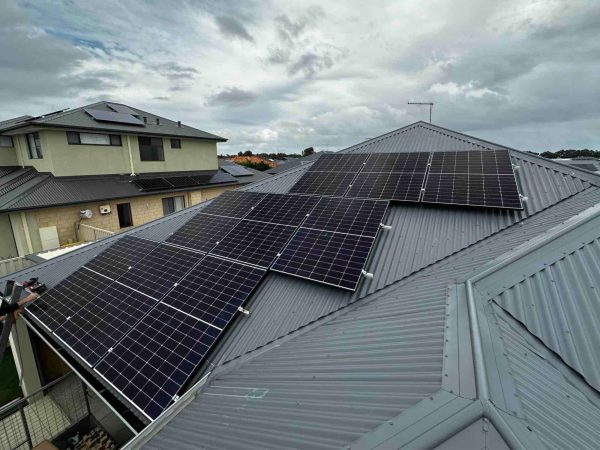Yes, you can fully power a house with solar panels. However, going completely off-grid typically requires investing in enough solar batteries and panels to meet your energy requirements. The more energy your house uses, the more solar panels you will need. For most homeowners, combining solar power with grid connection offers a sufficiently cost-effective approach to reducing energy bills and minimising environmental impact.

Understanding Solar Power
Solar power harnesses the energy from the sun using solar panels, which convert sunlight into electricity. This electricity can be used immediately, stored in batteries, or even fed back into the grid. Solar panels are typically installed on rooftops where they can receive maximum sunlight exposure.
Solar panel systems consist of several components:
- Solar Panels: These are the key components that capture sunlight and convert it into direct current (DC) electricity.
- Inverter: Converts DC from the solar panels into alternating current (AC), which is usable by standard home appliances.
- Battery Storage: Optional, but vital for storing excess energy for use during periods without sunlight, like nighttime or cloudy days.
- Monitoring System: Tracks the performance and efficiency of your solar power system.
Assessing Your Energy Needs
Before committing to fully powering your home with solar panels, it’s crucial to understand your household’s energy consumption. Assessing your energy needs involves:
- Review your past energy bills to determine average monthly and yearly energy usage.
- Identify major energy-consuming appliances and consider if they can be used more efficiently or replaced with energy-saving versions.
- Consider lifestyle changes that could reduce energy consumption, thus impacting the size of the solar system you need.
Many times, using a less energy-intensive appliance and adopting energy-saving habits can significantly reduce the number of solar panels required to power your home completely.
Determining the Right Number of Solar Panels
The number of solar panels needed to power a house fully depends on several factors:
- Energy Consumption: A larger home or those with greater energy demands will require more panels.
- Sunlight Exposure: Homes located in regions with more sunny days per year will need fewer panels.
- Panel Efficiency: Higher efficiency panels produce more electricity, so fewer panels may be needed.
- Roof Space: Adequate space to install the necessary number of panels without shading.
For an average Australian household consuming about 20 kWh per day, a typical solar system size would range between 5 kW to 10 kW, depending on the factors mentioned.
Learn more: How many solar panels do I need?
The Role of Battery Storage
Battery storage plays a significant role in fully powering a house with solar. During sunny periods, your solar panels will often produce more electricity than your household needs. Solar batteries store this excess energy for use during less sunny periods, such as nighttime, ensuring you have a constant power supply.
There are a variety of battery options to consider, from high-end solutions like the Tesla Powerwall to more budget-friendly options. When choosing a battery, consider:
- Storage Capacity: Enough to cover daily energy needs.
- Depth of Discharge (DoD): Indicates how much of the battery’s capacity can be used.
- Round-Trip Efficiency: The percentage of energy put into the battery that can be retrieved.
- Lifespan and Warranty: Ensure the battery lasts long enough to justify the investment.
Financial Considerations
Switching to solar power is a significant investment that can pay off over time through reduced energy bills. Financial factors to consider include:
- Upfront Costs: Solar panels, inverter, battery storage, and installation costs.
- Government Incentives: Solar rebates and incentives, such as the Small-scale Technology Certificates (STCs), which can reduce the cost.
- Return on Investment (ROI): Calculate the payback period and savings over the solar system’s lifespan. Most systems break even in under ten years.
Challenges and Considerations
While the benefits of solar energy are extensive, some challenges include:
- Initial Investment: High upfront costs can be a barrier for some homeowners, although financing options are often available.
- Roof Space Requirements: Not all roofs are suitable for solar panel installations due to shading, orientation, or size.
- Intermittency: Solar power is weather-dependent, making battery storage solutions important for ensuring energy reliability.
Considering solar for your home?
Fully powering a house with solar panels is possible, but requires a significant investment in a solar battery system. By carefully considering your energy needs, maximising your home’s energy efficiency, and selecting the right solar and battery systems, you can achieve greater energy independence. With the support of governmental incentives and the decreasing cost of solar technologies, now is a fantastic time to consider this transition.
At Perth Solar Force, we are committed to helping you make this dream a reality. Our team of experts is here to guide you through every step, from assessing your energy requirements to installing the ideal solar system for your home. Let us help you harness the power of the sun for a greener, more sustainable future.
